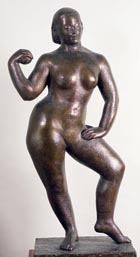Research Questions
Mapping Sculpture 1851-1951 is investigating the practice and profession of sculpture from a new perspective by exploring four key questions that will transform the way the medium is seen and understood.
How does examining the working relationship between sculptors and related businesses and trades change accepted ideas of authorship and status?
Focus on the sculptor as the sole creator of handcrafted works has overshadowed the uniquely collaborative nature of the sculptural medium. An investigation of studio assistants, carvers, foundries and other specialist craftsmen, many of whom were practitioners in their own right, is necessary to reveal their contributions to the creative process.
What can we learn about the role of networks and infrastructures in supporting art practice by tracing sculptors' personal and institutional connections?
Numerous societies and associations were formed in this period but their impact on sculpture is little understood. An in-depth study, particularly of the vital partnerships between sculptors and architects, is needed to throw new light on the relationship between the studio and the public domain.
To what extent does investigating the diversity of sculptors' practices challenge conventional critical hierarchies of subject, medium and form?
The status attached to monumental, ideal and, latterly, abstract work has sidelined a significant portion of sculpture produced in the period. An exploration of the full range of practice is an essential precursor to understanding sculptors' responses to changing patterns of consumption and synthetic approaches to art and design.
What is the impact on current understanding of cultural geographies of making an integrated study of sculptural practice in Britain and Ireland?
A London-centric perspective has often marginalized broader investigations of cultural geographies, including more nuanced discussion of the relationship between the metropolis and the regions. A broad survey is required to trace the relationship between economic growth and the emergence, from the mid-nineteenth century, of new art infrastructures and diversified markets at home and overseas.

QUICKLINKS

